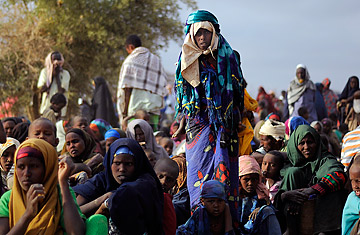
Somali refugees wait at a registration center at the Dagahaley refugee site within the sprawling Dadaab complex in Kenya on Aug. 2, 2011
(2 of 2)
The camps had been badly overcrowded for years, and since January had been receiving 10,000 refugees a month — already a huge number. But it was not until that monthly number surged to 30,000 in June that the media and the politicians took notice. "They only come in when they can actually witness the situation," said the aid official, a veteran of the camps, who was not authorized to speak on the record. "They want to see if it is really true that kids are malnourished."
The current wave of attention from the media and international donors is leading to commitments of millions of badly needed dollars, but this is a long-term crisis that the world has only just woken up to. "Unfortunately, when we get the support and response from donors, it is only after they see this in the media," said William Spindler, spokesperson for the U.N. High Commissioner for Refugees in the Dadaab refugee complex. If donors had reacted in a timelier manner, the relief agencies could have increased staffing, stockpiled more supplies, and set up reception centers closer to the Somali border — all things that would have alleviated the current chaotic crisis.
There is currently a massive backlog of refugees: more than 30,000 people who have to wait up to two weeks to get registered — meaning no housing and limited rations. The severely strained resources have led to a three- to six-fold increase in child deaths. "We are very aware that we are not responding to the needs as fast as we should be," said Spindler, who said that the problem stemmed from a combination of the overstretched U.N. relief agency and the particularly bad condition of the arriving refugees.
U.S. aid officials admit their frustration at the current chaos and say that longer-term development efforts are needed to prevent the same thing from happening again. "We know that it is one-tenth the cost to provide effective agricultural support and help communities gain food security than it is to provide food aid at a time of famine, and [yet] we are standing right here providing food aid at a time of famine," Rajiv Shah, the head of USAID, told TIME as he visited a refugee intake center. "So we are working hard but this change doesn't happen overnight." He was on a visit to Dadaab to announce a donation of $28 million to the refugee crisis. (The U.N. refugee agency has said it needs an additional $145 million to deal with the crisis.) Meanwhile, dozens of refugees are crowded outside the gates of the reception center waiting to enter.
In the end we make it to the hospital run by the International Rescue Committee. Despite the delays, Mrs. Hassan and the child receive treatment in time. The next day I get a text message from Maash, the aid worker. He says Mrs. Hassan is now in stable condition, and so is her malnourished baby. "Jst 2 thank u for da support. The mother n her baby r vry stable... . Am glad we saved lives."
Loewenberg's trip to Dadaab was funded by the Pulitzer Center on Crisis Reporting
